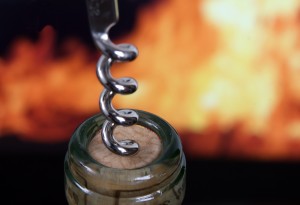 Up to this moment, even the wine list ordering anxiety was only amateur night compared to the angst of sending back your first bottle of wine. Your spouse is whispering to not draw attention, your guest may not know the difference in a chardonnay and pinot grigio and worse, there’s the impending stare from your waiter, the waiter who clearly thinks you’re trying to impress your dining partners.
Up to this moment, even the wine list ordering anxiety was only amateur night compared to the angst of sending back your first bottle of wine. Your spouse is whispering to not draw attention, your guest may not know the difference in a chardonnay and pinot grigio and worse, there’s the impending stare from your waiter, the waiter who clearly thinks you’re trying to impress your dining partners.
My mentor, wine writer Frank Prial said it brilliantly, “At best you will meet your trial with steadfastness and course … at worst you can console yourself that you’ve come a long way from the days when you were afraid to order the bottle in the first place.”
It’s not easy rallying the nerve to send a bottle of wine back or even questioning its condition but there are a few pointers and etiquette guidelines that can help ease the stress.
The ritual remains the same: The waiter opens the bottle, the person who ordered the wine will be asked if he would like to taste. Answer yes, and the waiter will pour a small amount. The diner will give it a quick sniff and take a sip, nodding yes if the wine is not tainted. Obviously, if the wine smells like a musty basement, dirty socks or vinegar you will tell your waiter, who will usually confirm the fault, retrieve a new bottle and begin again.
If you are dining in a restaurant with a knowledgeable staff this task will not be a debate or embarrassing conflict. Your waiter is opening the bottle for the first time at your table so consider from the beginning he is your ally. If you think the bottle has a fault, ask the waiter to taste the wine and offer his opinion. Knowledgeable staff will be able to evaluate and discuss the fault or aroma you are detecting.
Of course it doesn’t make sense to go through an entire dining experience with a bad bottle but there is a difference in a flaw and simply not enjoying the taste. Many times when ordering an unfamiliar varietal, vintage or region, the wine will express itself differently from traditional wines we drink on a regular basis.
This is important because many wines will have an unusual or unfamiliar aroma or taste very specific to the grape. For example, a beautiful old Burgundy pinot noir may have the aromas of barnyard, manure and a touch of mushrooms. It is important to understand this is not a fault but a unique character to the aging wine. Consider asking for a “tasting” pour, if the wine is available by the glass as well as bottle. This helps in the taste and fault confusion before ordering the bottle.
A last tip: the stemware could be the culprit. With industrial restaurant detergents and dishwashers, residue left on the glass can offset the aromas. Sometimes it may be as simple as asking to re-taste in a fresh wine glass.